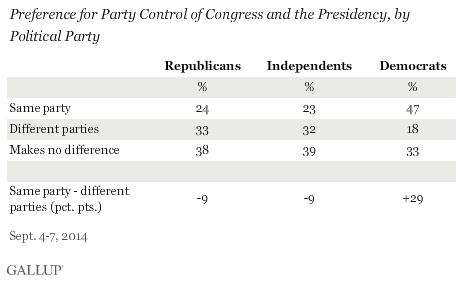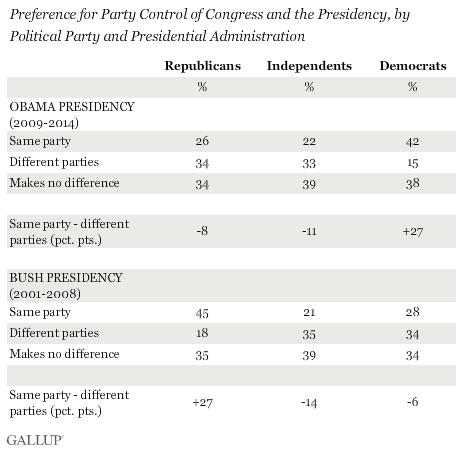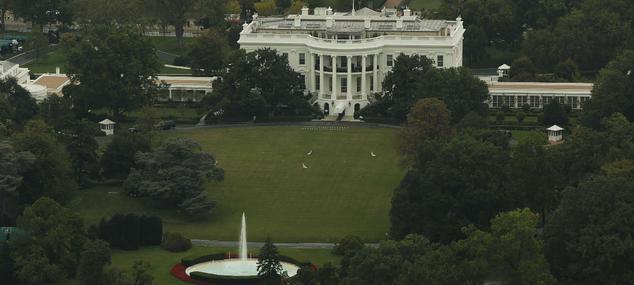PRINCETON, NJ -- Americans lack consensus on whether it is better to have one party holding the presidency and the majority in Congress, or better to have control of each branch of government split between the two major political parties. Currently, 30% say it is better to have a one-party government, 28% say a divided government is better, and the highest percentage, 37%, say it makes no difference.

The results are based on Gallup's annual Governance poll, conducted Sept. 4-7. Since Gallup first asked the question in 2002, Americans have not shown a clear preference on the most desirable form of government. Most often, the highest percentage have said it "makes no difference." The highest percentage in favor of one-party government was 38% in 2012 and the highest in favor of divided government was 36% in 2005.
Divided government has been the norm in U.S. politics for most of the last 45 years, with one party controlling both houses of Congress and the presidency for only 12 of those years -- 1977-1980, 1993-1994, 2003-2006 and 2009-2010, as well as part of 2001.
As such, Americans may simply be used to divided government and do not see it as better or worse than the alternative. But Americans have also seemingly rejected one-party government in the midterm elections that took place in 1994, 2006, and 2010, when a single party controlled Congress and the presidency and the public was dissatisfied with the way things were going in the country. In those midterms, the president's party lost control of one or both houses of Congress in highly successful elections for the opposition party.
Partisans' Preferences Influenced by Party of President
To a large degree, Americans' opinions on the desirability of divided versus unified party government may not be based on a theoretical or normative preference, but on which form of government would give their favored party the most power. Since a Democrat is currently president, Americans may now equate one-party government with a Democratic one-party government. Consistent with this, Republicans currently say they favor divided government over unified government by 33% to 24%, and Democrats favor one-party government by an even larger 29-percentage-point margin, 47% to 18%.

Underscoring that these preferences for divided versus unified government are influenced by which party is in the White House, Republicans have, on average, favored divided government during the Obama administration, but preferred one-party government when George W. Bush was president. Democrats, who favored divided government under Bush, now prefer one-party government with Barack Obama in office.

Independents' preferences have been consistent -- in favor of divided rather than unified government -- regardless of the party of the president.
Implications
Party control of the political branches of the U.S. government has typically been divided over the last 45 years. This has included times when a Republican president had to work with a Democratic Congress and when a Democratic president had to work with a Republican Congress. There have also been times, including currently, when party control of the two houses of Congress was divided.
There are certainly arguments to be made in favor of either divided or one-party government. If one party controls the presidency and Congress, it will have a much easier time passing legislation on policy that addresses the major issues facing the country. That arrangement also gives voters clear lines of accountability if people are happy or unhappy with the direction of the government, as was evident in voters' decisions to change party control of Congress in the 1994, 2006, and 2010 midterm elections.
Of course, if one party controls the federal government it may pursue policies that certain segments of the public do not like, and it could be up to two years before voters have the opportunity to change the partisan make-up of the government.
Divided government may also be seen as a way to ensure moderation in government policy, rather than it moving too far in a liberal direction if Democrats are in full control or too far in a conservative direction if Republicans are control. And having divided party control of government may be seen as another way to have checks and balances on the power of the various government institutions, in addition to those the founding fathers laid out in the Constitution.
Regardless of Americans' preferences, the U.S. is virtually certain to have divided government after this year's midterm elections, with President Obama in office for two more years and Republicans widely expected to retain their majority in the House of Representatives and with a reasonable chance of winning the majority in the Senate.
Survey Methods
Results for this Gallup poll are based on telephone interviews conducted Sept. 4-7, 2014, with a random sample of 1,017 adults, aged 18 and older, living in all 50 U.S. states and the District of Columbia.
For results based on the total sample of national adults, the margin of sampling error is ±4 percentage points at the 95% confidence level.
Interviews are conducted with respondents on landline telephones and cellular phones, with interviews conducted in Spanish for respondents who are primarily Spanish-speaking. Each sample of national adults includes a minimum quota of 50% cellphone respondents and 50% landline respondents, with additional minimum quotas by time zone within region. Landline and cellular telephone numbers are selected using random-digit-dial methods. Landline respondents are chosen at random within each household on the basis of which member had the most recent birthday.
Samples are weighted to correct for unequal selection probability, nonresponse, and double coverage of landline and cell users in the two sampling frames. They are also weighted to match the national demographics of gender, age, race, Hispanic ethnicity, education, region, population density, and phone status (cellphone only/landline only/both, and cellphone mostly). Demographic weighting targets are based on the most recent Current Population Survey figures for the aged 18 and older U.S. population. Phone status targets are based on the most recent National Health Interview Survey. Population density targets are based on the most recent U.S. census. All reported margins of sampling error include the computed design effects for weighting.
In addition to sampling error, question wording and practical difficulties in conducting surveys can introduce error or bias into the findings of public opinion polls.
View survey methodology, complete question responses, and trends.
For more details on Gallup's polling methodology, visit www.gallup.com.

